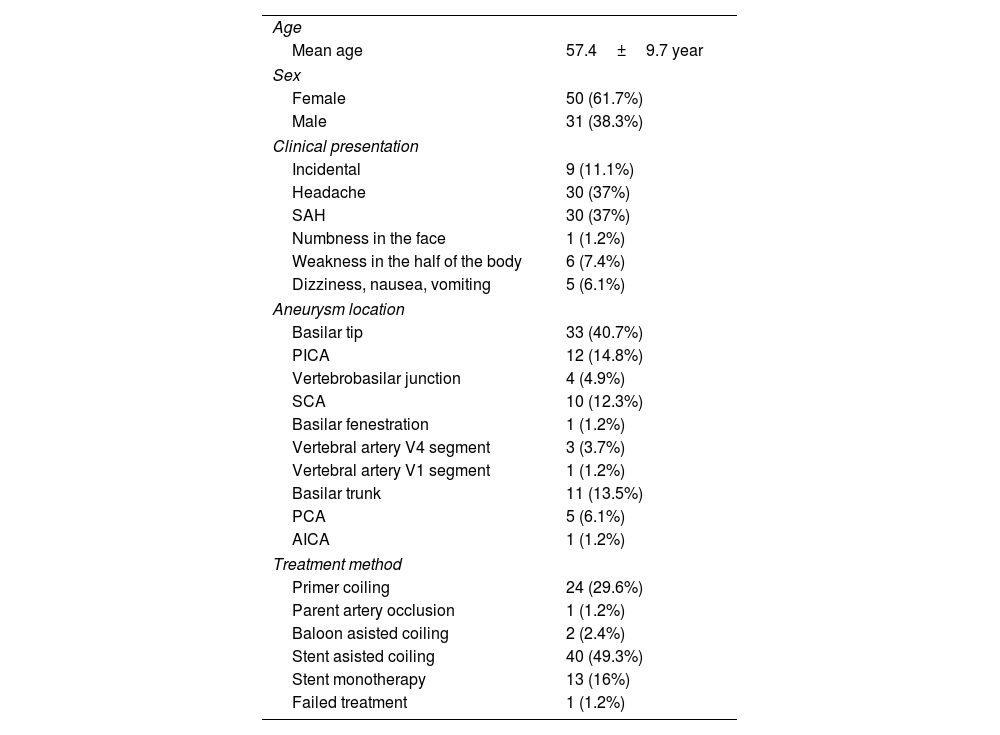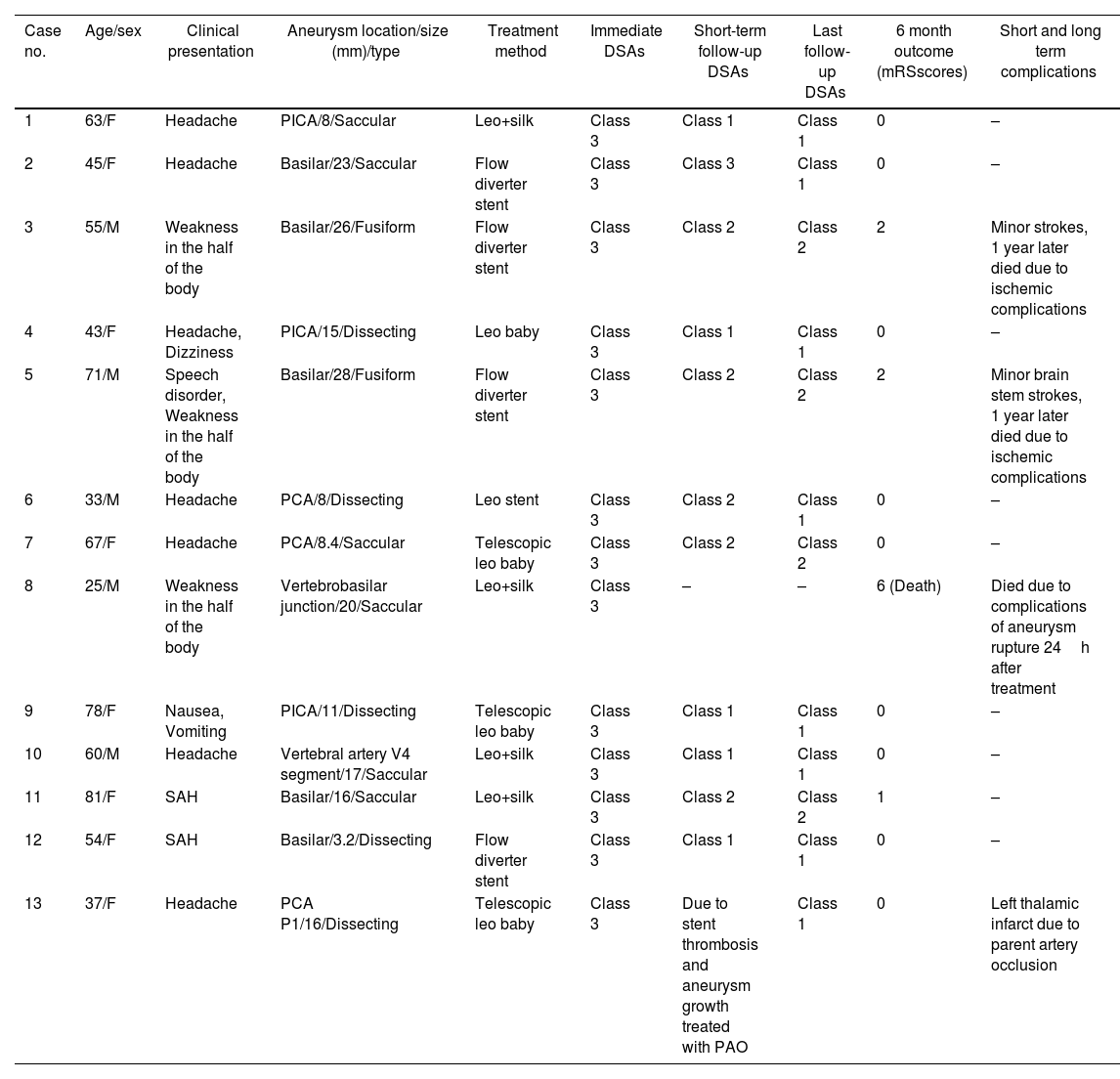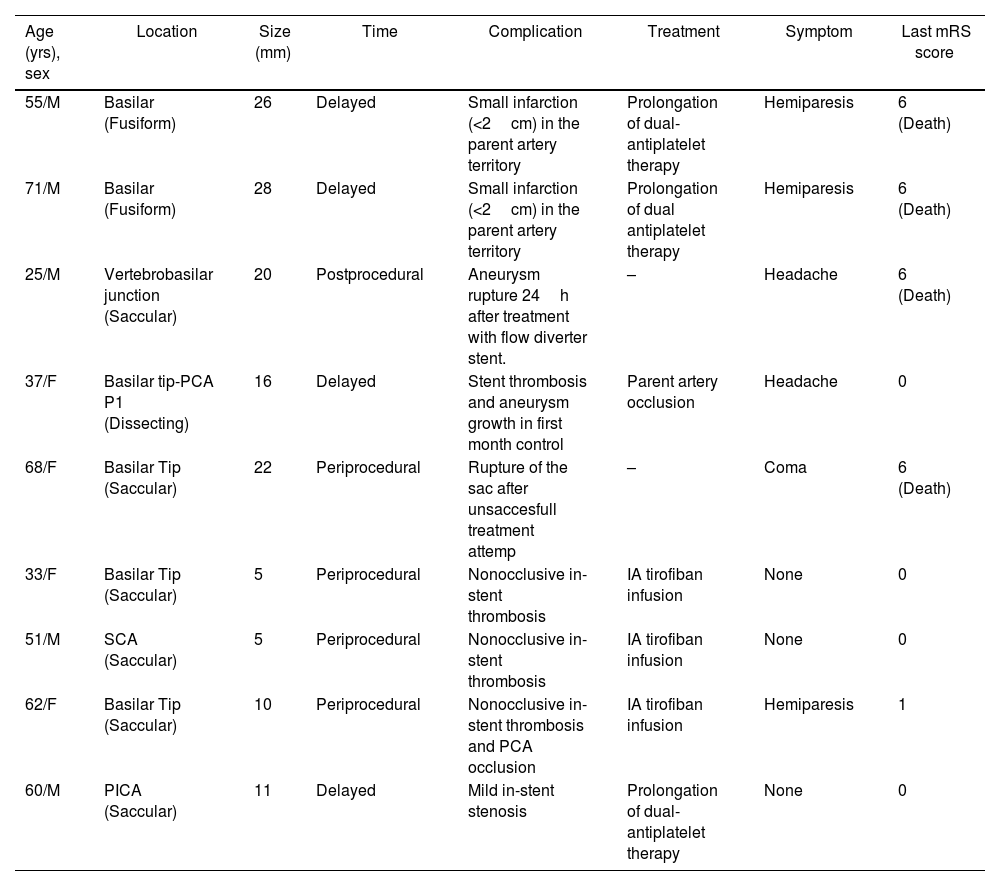Relatively constant surgical risks and rapid advances in endovascular treatment have caused a major shift toward endovascular management of posterior circulation aneurysms. This paper presents the results of a series of endovascularly treated posterior circulation aneurysms.
MethodsA total of 81 patients who underwent endovascular treatment of posterior circulation aneurysms performed by a single team between 2009 and 2019 were included. Demographic, clinical, radiologic, and management details were retrospectively obtained from hospital records.
ResultsAmong the included patients, 50 (61.7%) and 31 (38.3%) were female and male, respectively. Subarachnoid hemorrhage was observed in 30 patients (37%). Moreover, 40 (49.3%) aneurysms were treated with stent-assisted coiling, 1 (1.2%) aneurysm was treated with parent artery occlusion, 2 (2.4%) aneurysms were coiled using balloon assistance, 24 (29.6%) aneurysms were coiled primarily, 1 (1.2%) patient had an unsuccessful treatment attempt, and 13 (16.0%) aneurysms were treated with flow-diverter stents or stent monotherapy. During the last follow-up, 57 (83.8%) aneurysms were completely occluded, whereas 6 (8.8%) and 2 (2.9%) aneurysms did and did not have a residual neck, respectively. Flow diversion was used to treat 13 patients, among whom 8 had total occlusion or stable residue. A total of 7 deaths (8.6%) were encountered in this series.
ConclusionEndovascular treatment should be considered as the primary treatment modality for posterior circulation aneurysms. Despite the high morbidity and mortality rates, promising results can be achieved with correct patient selection. Flow diversion can be a feasible alternative for complex aneurysms that are difficult to treat.
Los riesgos quirúrgicos relativamente constantes y los rápidos avances en el tratamiento endovascular han provocado un viraje importante a dar preferencia al tratamiento endovascular en los aneurismas de la circulación posterior. Este artículo presenta los resultados de una serie de aneurismas de la circulación posterior tratados endovascularmente.
MétodosSe incluyeron un total de 81 pacientes que fueron sometidos a tratamiento endovascular de aneurismas de la circulación posterior realizado por un solo equipo entre 2009 y 2019. Los detalles demográficos, clínicos, radiológicos y de manejo del paciente se obtuvieron retrospectivamente de los registros hospitalarios.
ResultadosEntre los pacientes incluidos, 50 (61,7%) eran mujeres y 31 (38,3%) eran hombres. Se observó hemorragia subaracnoidea en 30 de los pacientes (37%). Además, 40 (49,3%) de las aneurismas se trataron con enrollamiento asistido por stent, 1 (1,2%) aneurisma se trató con oclusión de la arteria madre, 2 (2,4%) aneurismas se enrollaron con asistencia de balón, 24 (29,6%) aneurismas se enrollaron en espiral, 1 (1,2%) paciente tuvo fallo en el intento del tratamiento y 13 (16,0%) aneurismas fueron tratados con stents desviadores de flujo o con monoterapia de stents. Durante el último seguimiento, 57 (83,8%) aneurismas estaban completamente ocluidos, mientras que 6 (8,8%) y 2 (2,9%) aneurismas tenían y no tenían cuello residual, respectivamente. La derivación de flujo se utilizó para tratar a 13 pacientes, de los cuales 8 tenían oclusión total o presentaban residuo estable. En esta serie se contabilizaron un total de 7 muertes (8,6%).
ConclusiónEl tratamiento endovascular debería considerarse como la modalidad de tratamiento principal para los aneurismas de la circulación posterior. A pesar de las altas tasas de morbilidad y de mortalidad, se pueden lograr resultados prometedores con una correcta selección de los pacientes. La desviación del flujo puede ser una buena alternativa para los aneurismas complejos de difícil tratamiento.
Article

If it is the first time you have accessed you can obtain your credentials by contacting Elsevier Spain in suscripciones@elsevier.com or by calling our Customer Service at902 88 87 40 if you are calling from Spain or at +34 932 418 800 (from 9 to 18h., GMT + 1) if you are calling outside of Spain.
If you already have your login data, please click here .
If you have forgotten your password you can you can recover it by clicking here and selecting the option ¿I have forgotten my password¿.













